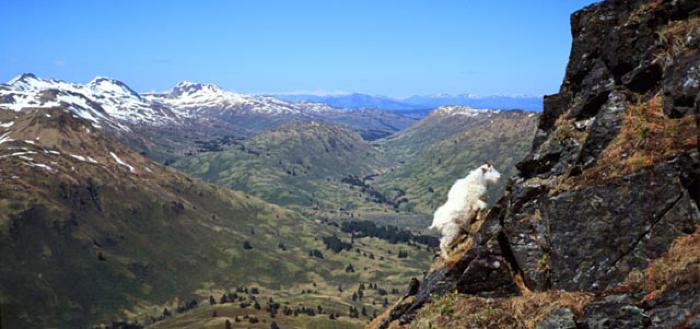Mountain Goat — PaRanaq, Pehnaiq

Mountain goats (Oreamnos americanus) are one of four large ungulate species introduced to Kodiak in the early twentieth century. These docile alpine grazers live on steep, rocky mountain slopes, where they eat grasses, herbs, and low-lying shrubs. The have pointed black horns, a thick white coat, and distinctive long hair along their backs, necks, shoulders, rumps, and legs. Mountain goats captured on the Kenai Peninsula were moved to Kodiak in 1952-53 and released in Ugak Bay’s Hidden Basin. Today there are more than 1,400 animals in the Kodiak region. A good hiker can get close to mountain goats, which rely on their rugged habitat for protection.
Although goats were not indigenous to Kodiak, Alutiiq people obtained their hair and horns in trade with the Chugach of Prince William Sound and the Dena’ina of the Kenai Peninsula. Alutiiq people used long goat hairs to embroider sewn objects and fashioned goat horn into elegant spoons. Craftsmen softened the horn with steam, bent it into shape, and carved it into intricate shapes. One of the Alutiiq words for mountain goat, paRanaq, is the same as the word for sheep.
A story from Prince William Sound indicates that Alutiiq hunters pursued goats with bows and arrows. To indicate ownership of a slain animal, a hunter might place an item of his clothing—a spruce root hat or a ground-squirrel parka—on the carcass. This gesture of respect also honored the goat’s spirit and welcomed it to the hunter’s village.
